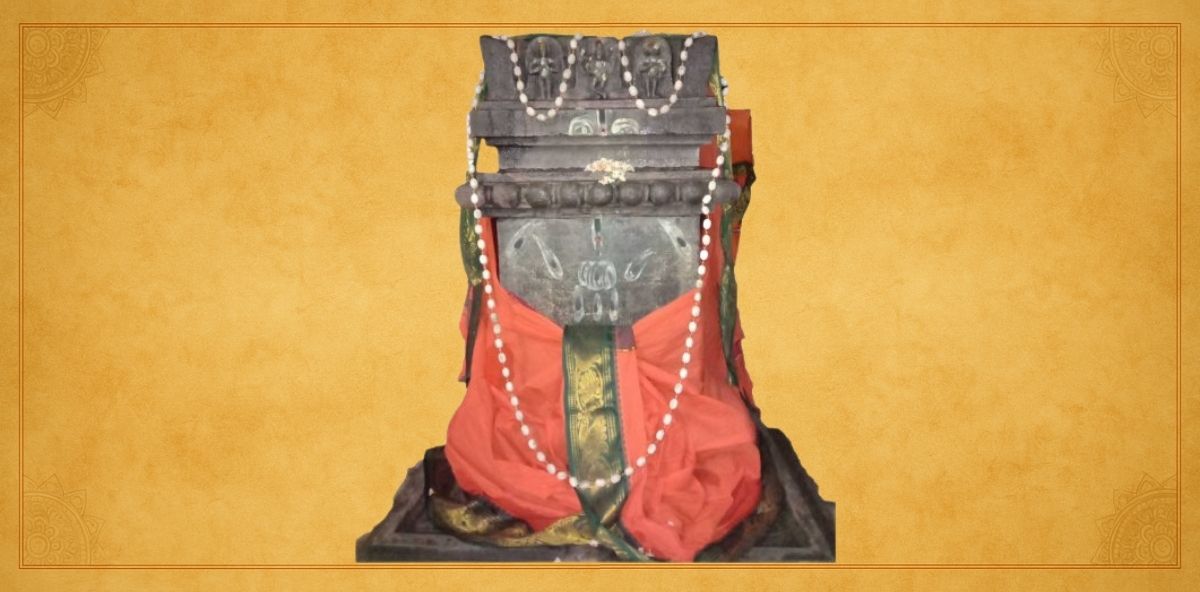Tenure: 1755 – 1770
Aradhana: Pushya Shukla Dvitiya
Location: Kumbakonam
Charama Shloka :
ವಿದ್ವತ್ಪಂಕಜಮಾರ್ತಾಂಡಃ ವಾದಿಮತ್ತೇಭಕೇಸರೀ | ಜಗನ್ನಾಥಗುರುರ್ಭೂಯಾತ್ ಜ್ಯಾಯಸೇ ಶ್ರೇಯಸೇ ಮಮ ||
विद्वत्पंकजमार्तांडः वादिमत्तेभकेसरी | जगन्नाथगुरुर्भूयात् ज्यायसे श्रेयसे मम ||
vidvatpaṅkajamārtāṇḍaḥ vādimattebhakesarī | jagannāthagururbhūyāt jyāyase śreyase mama ||
About Sri Jagannatha Tirtha
We understand from tradition that ancestors of Sri Jagannatha Tirtha belonged to Kaundinya Gotra, Shashtika Vamsha and a scholarly house named Tangedi. This family seems to have hailed from Varavani village that is located on the banks of Uttara Pinakini situated mid-way between Chikkaballapur and Gauribidanur. Lord Narasimha at Devarayanadurga was perhaps their family deity. We understand that families belonging to this household exist even now in Varavani and Doddaballapura as well.
As with his illustrious predecessors, there are a couple of very special observations about this saint that we come to know from tradition. The first of them is that he entered the fourth order Sanyasashrama directly from the first order Bala Sanyasi after Sri Vyasa Tirtha in the lineage of the Srimatha. The second is that he was better known by his honorary name Bhashyadipikacharya than his real name Sri Jagannatha Tirtha.
There are many legends associated with this Saint as recounted below:
Sometime after initiation, we understand from tradition that when an attempt was made by miscreants to steal his Devara Pettige, he jumped into Kaveri river and swam a long distance to safety. However, as he was injured in the process, he is supposed to have requested his guru Shesachandrikacharya to relieve him of the responsibility of being the junior pontiff as he was ineligible to continue further.
Sri Raghunatha Tirtha then seems to have built a Mantapa for him at Bhavani near Erode at the confluence of rivers Kaveri, Bhavani and invisible Amritavahini Guptagamini. This is the place where Sri Jagannatha Tirtha went on to compose his famed work Bhashya Dipika that earned him the honorary title ‘Bhashya Dipikacharya’. Bhashya refers to Acharya Madhva’s commentary on the Vedanta Sutra of Lord Vedavyasa while Dipika literally means lamp that provides light hence ‘Bhashya Dipika’ turned out to be work that illuminates the intricacies of Acharya’s Sutra Bhashya. It is unique since besides being a very detailed exposition of Acharya’s Brahma Sutra Bhashya. The saint additionally brought together all contributions starting from Pracina Tikakaras Trivikrama Pandita onwards. Tradition has hence bestowed this apt and honorific title on the saint for his contribution.
Even in this case, we can draw parallel with his famed predecessor Sri Jaya Tirtha. Tikacharya composed all his works at the Yaragola cave, while Bhashya Dipikacharya composed all his works at Bhavani Kalamantapam. Both Tikacharya and Bhashya Dipikacharya consecrated the Mukhyaprana Vigraha Grantha Sakshi Pranadevaru opposite the cave at Yaragola and Kalamantapam at Bhavani, respectively. While the vigraha of Jayatirtha’s Avesha Rupa Shesha Devaru is available in the Yaragola cave, the vigraha of Bhashya Dipikacharya is seen on one of the pillars of Bhavani Kalamantapam.
It seems as though it was Providence’s plan to give his dear servant enough time and privacy to devote to the arduous task of constructing the wonderful masterpiece which is held in very high esteem by the intellectual community. We further understand that his guru being immensely pleased with the composition, besides bestowing the said title also announced in public that Sri Jagannatha Tirtha would succeed him on the Pitha. The saint had a couple more equally meritorious works to his credit.
Tradition records one more instance when the saint was troubled by miscreants. He seems to have composed the below prayer on Lord Narasimha who appeared instantly from the mango tree nearby, destroyed those and saved him.
Āmrastambāt Samāgatya Tāmra Tuṇḍān Nihatyāyaḥ |
Namram Nŏumi Jagannātham Kamropattam Nṛkesari ||
The saint is believed to be the Avatara of Galava Rishi who hails from the Bhargava clan and who was a disciple of Sage Visvamitra and appears in Mahabharata as well as in the Puranas. Tradition recounts one more instance when a Sadhaka with numerous doubts on Shastra dreamt that only the Rishi can clear them. Bhashya Dipikacharya happened to visit his place the next day and he posed those questions. The saint seemed to have patiently answered all those questions to his satisfaction. He then recalls the dream, seeks the saint’s blessing, and recounts this instance to the public, revealing the saint’s Mula Rupa.
Though ordained earlier, the saint spent most of his time composing his works except perhaps on the visit to Trimakuta Kshetra with his guru when Shesachandrikacharya attained Haripada. He seemed to have returned to Tamilnadu, ordained Sri Srinivasacharya, a disciple of both his Guru and himself to fourth order with appellation Sri Srinatha Tirtha to the Pitha and attained Haripada at Kumbhakona. His is the first Vrindavana to be consecrated at the Srimatha at Kumbhakona.
PS: Sri Vidyaprasanna Tirtha has a wonderful composition on this saint – ‘Sri Jagannatha Tirthara Divya Mahimeyanu Rajisuva Haima Lipiyalli bareyali beku’.

